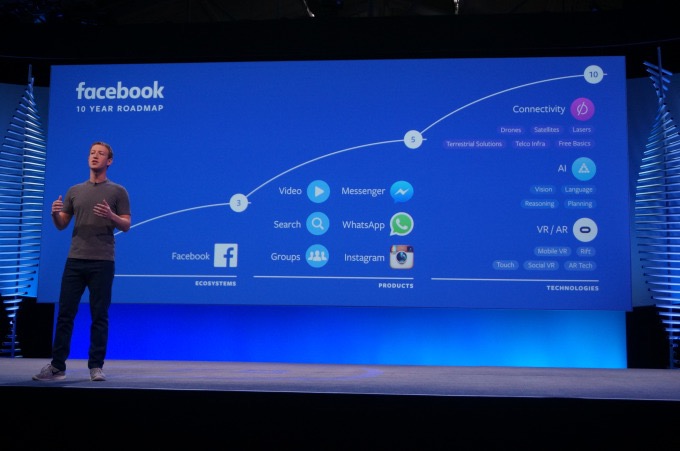Last Updated on April 17, 2017 by Larious
One of the biggest tech concepts we take for granted today was essentially unheard of before Facebook launched its Platform ten years ago. While there were “social networks”, the rest of the web didn’t care much about who you were or who you were friends with.
This is before we “logged in with Facebook” not just on it. Before sites were peppered with sharing buttons. Before every app wanted you to invite your contacts.
“The core thesis in 2007 was that if you looked at pre-2007 social networks, there were ‘social networks’ that were social, and basically everything else was not social” Facebook’s CEO Mark Zuckerberg tells me. “The theory was almost everything should have social components. I think that’s been born-out over the last decade.”
Yet opening its audience to outside developers came with a steep learning curve. Social apps must be accompanied by social norms about respecting people’s time and attention. Facebook is still getting the hang of that.
On its 10th anniversary, a series of interviews with Mark Zuckerberg and other team members reveal how the Facebook Platform shook out and shook everything up.
Table of Contents
Social By Design
In 2007, Facebook was experiencing unprecedented viral growth thanks in part to its freshly-launched News Feed. Given the right skeleton, it discovered people would flesh out a social network with not only their content, but their identities. The blue beast was alive. The scrappy young company could hardly keep up.
Yet the team had a hazy, crazy idea that belayed its humble dorm room beginnings. Facebook didn’t know what people wanted it to build, so what if it let anyone build apps on top?
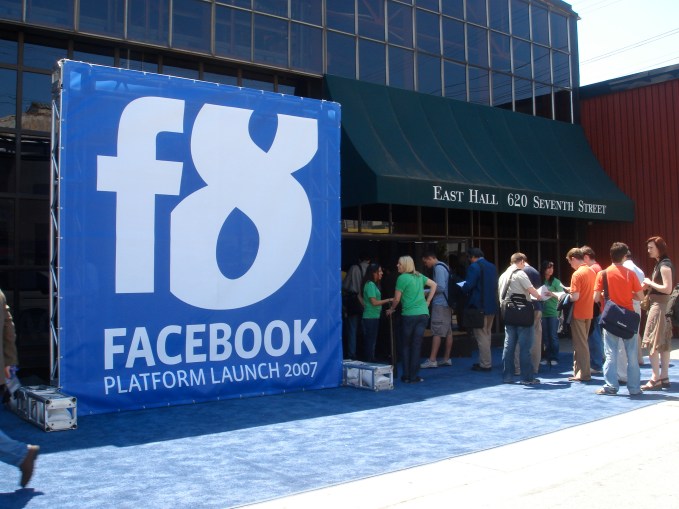
A year later with the launch of the Facebook Connect part of the platform, it posed another peculiar question: If we let people log in elsewhere with their Facebook account and bring along their interests and social graphs, could any website become “social”?
The answers would surprise Facebook’s executives, spawn a legion of new businesses, entrechng the company while changing the Internet from a solo experience to a group one. Those same answers would also force Facebook to adapt to unforeseen trends, retreat from unsustainably spammy features, and crater some of the new business built on the fledgling Platform. ‘
Word of mouth is a top driver of popularity for any product. Facebook’s “social by design” philosophy sought to give each app its own voice users could speak through to rally their friends to enhance their collective experience.
Suddenly, Facebook’s exclusive relationship with its users became a tumultuous, bizarre love triangle between itself, the public, and its developers. One where the users were put first, even if it meant sacrificing immediate monetization of its site and the existence of some app makers.
“Crazy Time”
“There was no playbook for what we were doing. No one had built this sort of platform before.” says Ami Vora, a Facebook Product Director who was part of the initial team of five core engineers working on the launch for the first F8 conference. “We didn’t exactly know what would happen next to the developer community. We were really just trying to learn what we were doing as we were doing it.”
Vora had been working at Microsoft, a more conservative tech titan. What we think of as the “closed private beta” stage of modern platforms before they launch and open up was how many platforms ran permanently. Current Platform team member and Facebook VP of partnerships Ime Archibong tells me he came from IBM, which was “known for building proprietary stacks up and down themselves.”
The promise of pioneering a new way to work with developers lured fresh talent to Facebook. And the geyser of user growth it had tapped into attracted developers thirsty for attention.
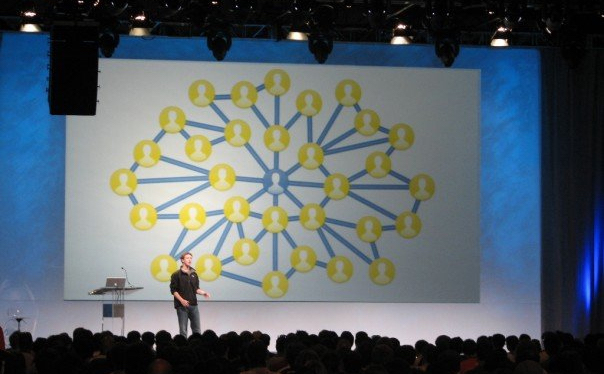
Mark Zuckerberg on stage at the first F8 in 2007
Vora describes the “sleepless excitement” of this hockey stick-growth moment at Facebook. “One of our catch phrases was “‘crazy time?’” Employees felt the immense gravity of this phase of Facebook’s ascent. “You’d just nod to the person you were passing [in the office] and say ‘crazy time?’”
In fact, employees spent the days running up to F8 frantically updating Facebook’s marketing materials. Everything said 19 million users, but Facebook hit 20 million in the days before the event. The company scheduled a “20 million users party” for a few weeks later, “but by then we had 25 million users” Vora laughs.
After running the conference all day where Facebook announced the Platform, the core team retreated to a nearby hotel’s conference room it had established as its “war room”. There, on a spotty Wifi connection and patchwork of mobile hotspots, Facebook’s Platform launched.
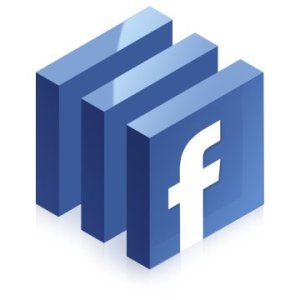 With V1, Facebook lets developers create “canvas applications” within its desktop site. These experiences could be personalized with a user’s identity, and connect people to friends who were also using the app. Developers could build games and social utilities, or offer a “Profile Box” app that let you spruce up your personal presence on Facebook.
With V1, Facebook lets developers create “canvas applications” within its desktop site. These experiences could be personalized with a user’s identity, and connect people to friends who were also using the app. Developers could build games and social utilities, or offer a “Profile Box” app that let you spruce up your personal presence on Facebook.
Facebook had dismantled two of the biggest barriers to people trying new web services. Users didn’t have to set up a separate username and password for each service, and they didn’t have to build a unique social graph there. Meanwhile, the lucrative viral channels helped developers rapidly build their audience as people invited their friends.
Within a few months, 7,000 apps had been built on the Facebook Platform. That number would grow to 33,000 in a year. In five years there were over 9 million apps and sites integrated with Facebook. And now after a decade Facebook has paid out almost $10 billion to its app developers.
“I remember talking to entrepreneurs in the weeks after F8 who were spending half of their day every day driving around trying to get whatever servers they could because they were experiencing so much growth” Vora says. Stanford University even created a Computer Science class where students had to build Facebook applications.
In 2008, Facebook opened the second wing of its Platform, “Facebook Connect”, which let third-party website from news publishers to utilities offer Facebook login, personalization, and instant sharing to the News Feed. Facebook effectively colonized the web, giving its citizens easy access abroad while funneling content back to the motherland. The Like button soon became Facebook’s calling card.
But while developers on Facebook’s platform would blossom into giant businesses like Zynga, others would end up as collateral damage as Facebook wrestled to control what it created.
Open To Surprises
The overarching strategy for Facebook’s Platform was that “it should be open. Anyone should be able to build on the platform” says Archibong. “Given that we aren’t going to be able to prioritize all this stuff, we don’t have enough engineers to build all the stuff we want to build, and arguably, we won’t know what the world and what people ultimately want, if we extend our Platform to developers, they’ll be able to build for these communities.”
That openness also forced Facebook to go where the platform pulled it. Sometimes that meant scrambling to support and survive unexpected success, as with gaming.
“I thought it was really fun. We all just threw sheep at each other”
Facebook didn’t quite predict how well its desktop canvas Platform would work for spreading simple social games. Eager for distraction and with dense social graphs on the network, the college-centered Facebook demographic frittered away immense amounts of time and money on games like Zynga Poker and FarmVille. Facebook would have to build an entire international payments infrastructure around the burgeoning games industry.
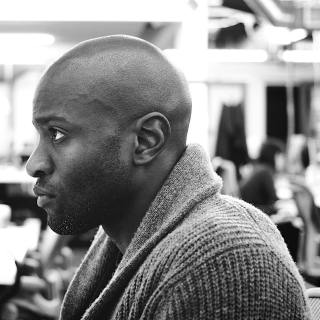
Facebook VP of Partnerhips Ime Archibong
But games also threatened to kill Facebook. What some considered playful socializing others found deeply annoying. Developers seized on the viral invite and request channels Facebook offered, designing their games to heavily reward users who sucked in their frends. You either spent hours and hours watering your make-believe FarmVille crops, paid real money to keep them alive, or begged your friends to sign up and help you.
“I thought it was really fun” Vora says wistfully, showing the strength of Facebook’s cult Kool-Aid. “Remember with ‘SuperPoke’ we all just threw sheep at each other!?! Who knew that would bring so much joy. [It was] an interesting way to express your friendship with someone and bring just a little touch of lightness to your day.” 60 million people ended up hooked on FarmVille, deriving some kind of value from the game.
Developing Whiplash
Others did not think it was really fun. I did not think it was really fun. Facebook had been a way to connect online about your real life, not play pretend in a frivolous virtual universe. Sure, some might find companionship in cooperating around games. But the News Feed of updates about friends’ vacations and new jobs was overrun with viral game spam.
Zuckerberg eventually admitted half of Facebook might not want to see this content, severely curtailed its prominence in the feed, and thereby dashed the growth dreams of some developers. Meanwhile Facebook removed the entire Profile Box part of the Platform after profile customization ran amok and put the site in danger of becoming another slow-loading, buggy mess like Myspace.
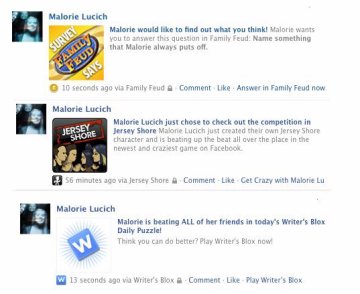
Facebook game spam
Had these parts of the platform remained unchecked, they might have poisoned the populace before other developers could try their hand with chatbots and camera effects a decade later. Still, some devs felt like Facebook had pulled the rug out from under them. Startups had raised money and hired employees, betting on Facebook’s Platform to distribute their products. It was the developers who got the short end as Facebook tried to balance their needs with its own and those of the users.
This is a theme that’s played out over and over in the 10 years since.
The struggle to find this balance might stem from Facebook’s seemingly naive perspective that its partners prioritize the long-term satisfaction of the social network’s users, and Facebook by proxy, as Facebook does itself.
“Everyone knew we were building an ecosystem, and no one would be successful unless we were doing the right thing for people” Vora insists. “Even the hard conversations were grounded in this knowledge.”
“The ability to take such a long-term view on things I think allows you to have open, candid conversations about what the future looks like with partners” says Archibong. “That may mean . . . things that were arguably not as good anymore for the partner or the developer but that we collectively knew were good for people over the long-run.”
But this framework falsely delineates between the needs of users and Facebook. If developer spam drowned out the social content people came to Facebook for, the users would have a bad experience…but that would quickly lead to them leaving the social network, depriving it of fulfilling its mission and filling its bank accounts.
This prioritization has kept users happy, Facebook earnings billions of dollars in profit per quarter, and its Platform open to new waves of developers. But it’s also left a trail of dead apps and battered businesses.
Zynga struggled as a public company after Facebook deleted viral channels that helped it get huge in the early days of the Platform. BandPage, makers of landing tab app for musicians’ Facebook Pages, was once the second-most popular developer behind Zynga and had just raised a $16 million Series B. But when Facebook decided these landing tabs made the user experience ‘inconsistent’ and suddenly shut them down, BandPage lost 90% of its traffic. It dropped from 35 million active users to 3 million in a few months, and after several failed pivots was sold to YouTube in a firesale for a fraction of the cash it had raised.
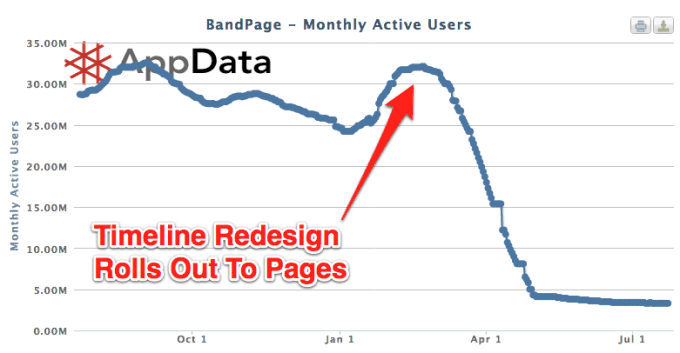
BandPage lost 90% of its users after Facebook suddenly killed off the Page landing tab part of its Platform
Yet Vora and Archibong repeatedly defended the limitations and changes to Facebook’s Platform as consensual. “I think most of those folks also understood, and were excited about the power they had gotten from the Facebook Platform. iLike woke up the next morning with 50k users, which was something they never expected” Vora recalls. She doesn’t mention that iLike withered after the Profile Box was shut down.
Archibong defends the tumultous point of Facebook’s history, saying “You actually find that conversations that from the outside looking in may look really difficult and probably seem really tough because they have both business impact for Facebook or the developer are actually okay because it’s not a transactional relationship.”
Maybe not for Facebook. With enough traction and network effect, it could outlive its Platform pivots. Still, for some developers, diverting their roadmap in search of Facebook-fueled growth was a transaction where the Platform’s exchange rate suddenly spiked.
Facebook would spend the next few years trumpeting its “Operation Developer Love”, where it tried to give app makers more warning about big changes on the roadmap and work with them more closely to ensure they were earning enough to validate the engineering time they poured into the Platform.
Balancing The Bizarre Love Triangle
The cycle of “too much virality -> too much spam -> dial back virality -> pivot the platform” has played out nearly a half dozen times since.
In 2011 Facebook launched the Open Graph platform to let apps like Spotify or Wall Street Journal’s Facebook News Reader automatically publish users’ listening or reading activity to the News Feed.
Facebook ended up reducing the number of music stories in the main News Feed and removing the side “Ticker” that embarassed people by sharing their guilt pleasure rock-outs with everyone they know. When Facebook decided stories about users opening click bait articles in Open Graph News Readers weren’t valuable enough, it downranked the apps, traffic dried up, and publishers abandoned that part of the platform.
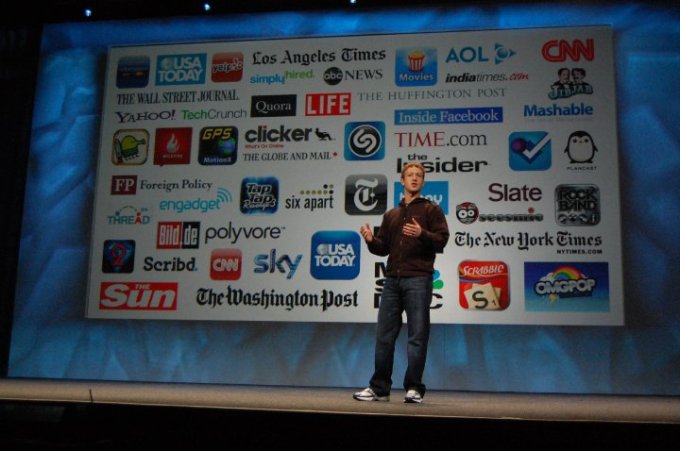
Mark Zuckerberg discusses Facebook’s Platform partnerships with news outlets at F8 2010
On the other side of the spectrum, that same year Facebook tried to launch its own HTML5 mobile web app platform. It had been shut out of charging the same 30% tax on game payments it did on desktop computers when users shifted iOS and Android devices. But this time Facebook gave developers too few growth option, and weary from its past waffling, they never adopted Facebook’s “Project Spartan” and that Platform dried up.
Most recently, Facebook’s Instant Articles promised a publishing platform that would drive more traffic for news outlets that host their content inside Facebook’s app so it loads faster. But Facebook’s iron grip on how publishers could show ads, email newsletter widgets, subscription sign-ups, and their own design identity made the format a bad deal.
Instant Articles essentially turned publishers into ghost writers, creating dumb content for Facebook’s smart pipes rather than deepening their relationships with readers directly. Facebook tried to loosen up, but now major oulets like The New York Times, Vice News, and the Los Angeles Times have abandoned Instant Articles.
Playing The Long-Game
Clearly Facebook is still grappling with how to give developers enough support that they join its Platforms but not so much that they disrupt the network’s equilibrium. Where it’s succeeded is internalizing one thing it got wrong 10 years ago: as long as you don’t drive the users away, you always get another chance.
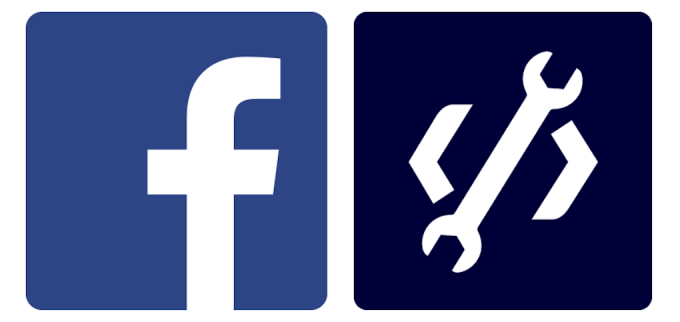
News articles were kept from overshadowing personal updates, and now publishers still see a massive chunk of referral traffic from the News Feed. Facebook dumped HTML5, but now is spinning up new games Platforms within Messenger and a new Steam-like desktop app. Open Graph auto-sharing fizzled, but Facebook’s Account Kit has flourished by allowing any app to use phone numbers and SMS for sign-up.
Whether Facebook is getting better at managing developer expectations or it just holds enough power to offset some missteps, it’s managed to keep its Platform well-populated. And now Facebook is expanding the definition of “developer” to include brands, small businesses, and more.
Zuckerberg tells me a high percentage of top-grossing mobile apps offer Facebook login or other Platform features. “I think that’s pretty widespread, but then even the ones who aren’t using our tools I think have generally adopted this apporach of every app, whether it’s an enterprise app or whatever it is, I think should have some kind of social sharing. I think that that idea, that’s been pretty cool to see.”
Now Facebook is prepping a “Camera Effects Platform” to let developers help you augment your photos and videos. Snapchat also wants to give you a breadth of creative tools to enhance your social media sharing, but has never cultivated a developer ecosystem before.
With so many mistakes to make and fragile balances to maintain, a decade of wisdom could give Facebook a leg up over younger competitors. Though it doesn’t have a perfect track record as a Platform, at least Facebook does have a track record. Being older than some of its own users might not be cool, but it has its advantages.

